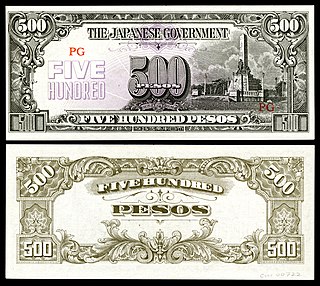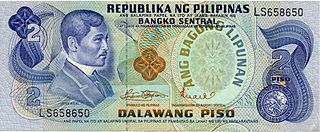 W
WBarter rings are ring-shaped gold ingots used as currency in the Philippines until the 16th century. These barter rings are bigger than a doughnut in size and are made of nearly pure gold.
 W
WEmergency circulating notes were currency printed by the Philippine Commonwealth Government in exile during World War II. These "guerrilla pesos" were printed by local government units and banks using crude inks and materials. Due to the inferior quality of these bills, they were easily mutilated.
 W
WThe Flora and Fauna Series was a series of Philippine peso coins minted from 1983 to 1994, in denominations from 1 sentimo to ₱2. The series used the Optima typeface. The sizes of the coins were reduced, and ₱5 coins were reintroduced, in 1991. Production of 50-sentimo and ₱2 coins ceased in 1995.
 W
WDuring World War II in the Philippines, the occupying Japanese government issued a fiat currency in several denominations; this is known as the Japanese government-issued Philippine peso. The Second Philippine Republic under President José P. Laurel outlawed possession of guerrilla currency, and declared a monopoly on the issuance of money, so that anyone found to possess guerrilla notes could be arrested or even executed.
 W
WThe Philippine fifty-centavo coin (50¢) was a denomination of Philippine currency. It was minted for the Philippines from 1864 to 1994 and was demonetized in 1998.
 W
WThe Philippine half-centavo coin (½¢), a denomination of Philippine currency, was issued when the Philippines was under US administration. It bears the names of both countries: Filipinas and the United States of America.
 W
WThe Philippine one-peso note (₱1) was a denomination of Philippine currency. On its final release, José Rizal was featured on the front side of the bill, while the Declaration of the Philippine Independence was featured on the reverse side.
 W
WThe Philippine peso fuerte was the first paper currency of the Philippines and the Spanish East Indies during the later Spanish colonial period. It co-circulated with other Spanish silver and gold coins and was issued by El Banco Español Filipino de Isabel II. The banknotes were convertible to either silver pesos or gold coins at the bank's discretion. The colonial government at the time allowed El Banco Español-Filipino to issue pesos fuertes up to one-fourths of its subscribed capital, or a maximum of PF 100,000, which was subsequently raised to 300,000 in 1855.
 W
WThe Philippine two-peso coin (₱2) was a denomination of Philippine currency. It was minted by the Bangko Sentral ng Pilipinas from 1983 to 1994 and was demonetized in 1998.
 W
WThe Philippine two-peso note (₱2) was a denomination of Philippine currency. On its final release, José Rizal was featured on the front side of the bill, while the Declaration of the Philippine Independence was featured on the reverse side.
 W
WPiloncitos are tiny engraved gold coins or weights found in the Philippines from the Archaic period.